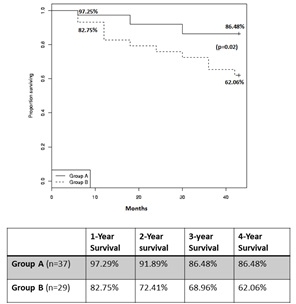Assessing the Role of Everolimus in Reducing Hepatocellular Carcinoma Recurrence After Living Donor Liver Transplantation for Patients within UCSF Criteria: Re-Inventing the Role of Mammalian Target of Rapamycine Inhibitors.
Organ Transplantation, China Medical University Hospital, Taichung, Taiwan.
Meeting: 2016 American Transplant Congress
Abstract number: A187
Keywords: Immunosuppression
Session Information
Session Name: Poster Session A: Liver - Hepatocellular Carcinoma and Cholangiocarcinoma Malignancies
Session Type: Poster Session
Date: Saturday, June 11, 2016
Session Time: 5:30pm-7:30pm
 Presentation Time: 5:30pm-7:30pm
Presentation Time: 5:30pm-7:30pm
Location: Halls C&D
The antineoplastic effects of everolimus(EVR) in adjuvant to its conventional immunosuppressive role in post-transplant setting can theoretically reduce the tumor recurrence in hepatocellular carcinoma(HCC)patients undergoing living donor liver transplantation (LDLT).In this second stage of our ongoing study, we intend to analyze the effects of EVR as an immunosuppressant on HCC recurrence when started in early phase after LDLT.
Methods:From Jan 2011 to Jun 2013, a total of 250 patients underwent LDLT at our institute. The HCC patients within the UCSF criteria were included in the study and divided in two groups:Group A(n=37)-EVR+calcineurin inhibitor(CNI)immunosuppressive therapy, Group B(n=29)-CNI based immunosuppression. EVR was started for group A recipients as early as 4th to 21st post-operative day after LDLT. The mean follow up period was 46 months (range, 34 to 58 months).
Results:The trough level for the EVR was3.47 ± 1.53 ng/ml (range, 1.5-11.2) for a daily dose of 1.00 ± 0.25 mg /day. For tacrolimus, the average trough level was 6.97 ± 3.98 ng/ml (range, 2.50 to 11.28 ng/ml). The 1-year, 3-year and 4-year overall survival achieved for Group A patients was 94.95%, 86.48% and 86.48%, respectively while for Group B patients it was 82.75%,68.96%, and 62.06%, respectively (p=0.02)(Figure1). There were no complications related to hepatic arterial thrombosis, wound infection or incisional hernia in either of the groups. However, for group A recipients, a significant leucocyte count drop [4.95 x 103cells/mm3(p<0.001)] at 6 months post-transplant was noticed.
Conclusion: This retrospective study shows a significant correlation of EVR+TAC based immunosuppression therapy & long term survival of the LDLT recipients that have HCC within the UCSF criteria. The major risk factor for the recurrence of the HCC was found to be vascular invasion and increased age of the recipients. As per our experience, the positive impact of EVR on the reduced HCC recurrence is more significant if EVR is started early phase after LDLT.
CITATION INFORMATION: Jeng L.-B, Thorat A, Yang H.-R, Chen T.-H, Hsu S.-C. Assessing the Role of Everolimus in Reducing Hepatocellular Carcinoma Recurrence After Living Donor Liver Transplantation for Patients within UCSF Criteria: Re-Inventing the Role of Mammalian Target of Rapamycine Inhibitors. Am J Transplant. 2016;16 (suppl 3).
To cite this abstract in AMA style:
Jeng L-B, Thorat A, Yang H-R, Chen T-H, Hsu S-C. Assessing the Role of Everolimus in Reducing Hepatocellular Carcinoma Recurrence After Living Donor Liver Transplantation for Patients within UCSF Criteria: Re-Inventing the Role of Mammalian Target of Rapamycine Inhibitors. [abstract]. Am J Transplant. 2016; 16 (suppl 3). https://atcmeetingabstracts.com/abstract/assessing-the-role-of-everolimus-in-reducing-hepatocellular-carcinoma-recurrence-after-living-donor-liver-transplantation-for-patients-within-ucsf-criteria-re-inventing-the-role-of-mammalian-target-o/. Accessed December 9, 2025.« Back to 2016 American Transplant Congress
